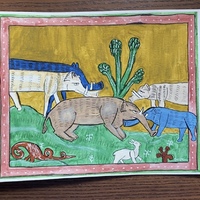Recreation of Rochester Bestiary’s “Elephants” in Gouache and Pencil Crayon
Item
Title
Recreation of Rochester Bestiary’s “Elephants” in Gouache and Pencil Crayon
Description
For my project, I recreated a bestiary painting of a group of elephants. The original art piece was created for an illuminated manuscript, the Rochester Bestiary. The bestiary is estimated to have been made around 1230, and was owned by a priory in Rochester, hence how it got its name. The illustrations in the bestiary were done with paint on parchment.
To recreate this painting, I began by making some practice sketches to get a general feel for the shapes in the painting. I then did a more detailed sketch on watercolour paper, and then went in with my gouache paints. Gouache is similar to watercolour in that it is a water-based paint, but it is more opaque than watercolour. I felt this type of paint would suit the recreation better, given that the original piece has such rich colours. After my gouache layer dried, I outlined the shapes and added details with a black pencil crayon. Finally, I added highlights with a white gel pen.
As part of my project, I also did some research in medieval art history. Medieval art spanned a large period, and is generally categorized into different eras: Early Christian art, Byzantine art, Pre-Romanesque and Romanesque art, and Gothic art. All these eras are united by common characteristics; medieval art was largely religious in nature, and Christian imagery was ubiquitous. Artists at the time also generally valued abstract and expressionist styles over realism.
To recreate this painting, I began by making some practice sketches to get a general feel for the shapes in the painting. I then did a more detailed sketch on watercolour paper, and then went in with my gouache paints. Gouache is similar to watercolour in that it is a water-based paint, but it is more opaque than watercolour. I felt this type of paint would suit the recreation better, given that the original piece has such rich colours. After my gouache layer dried, I outlined the shapes and added details with a black pencil crayon. Finally, I added highlights with a white gel pen.
As part of my project, I also did some research in medieval art history. Medieval art spanned a large period, and is generally categorized into different eras: Early Christian art, Byzantine art, Pre-Romanesque and Romanesque art, and Gothic art. All these eras are united by common characteristics; medieval art was largely religious in nature, and Christian imagery was ubiquitous. Artists at the time also generally valued abstract and expressionist styles over realism.
Contributor
Emma Topp

